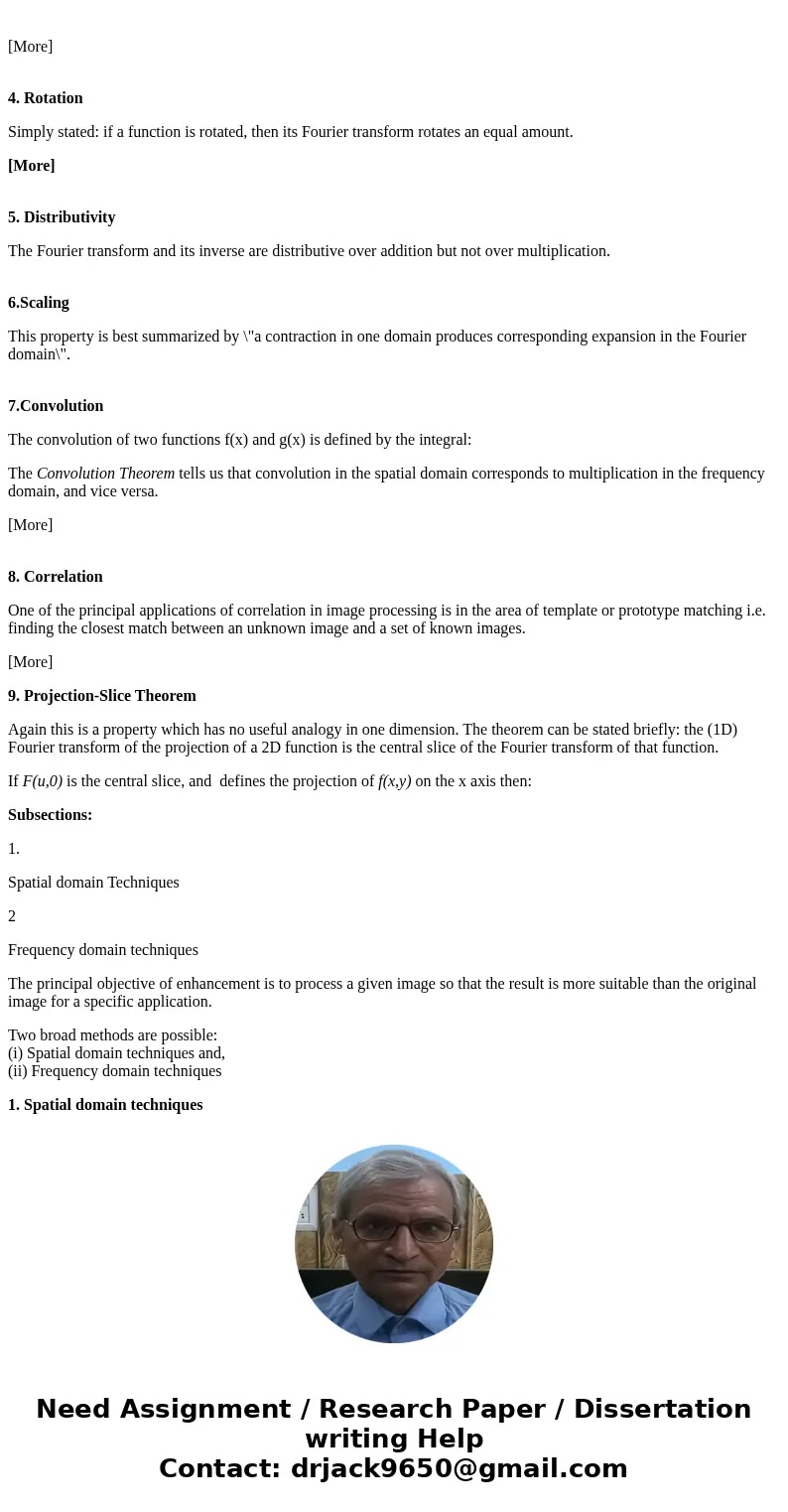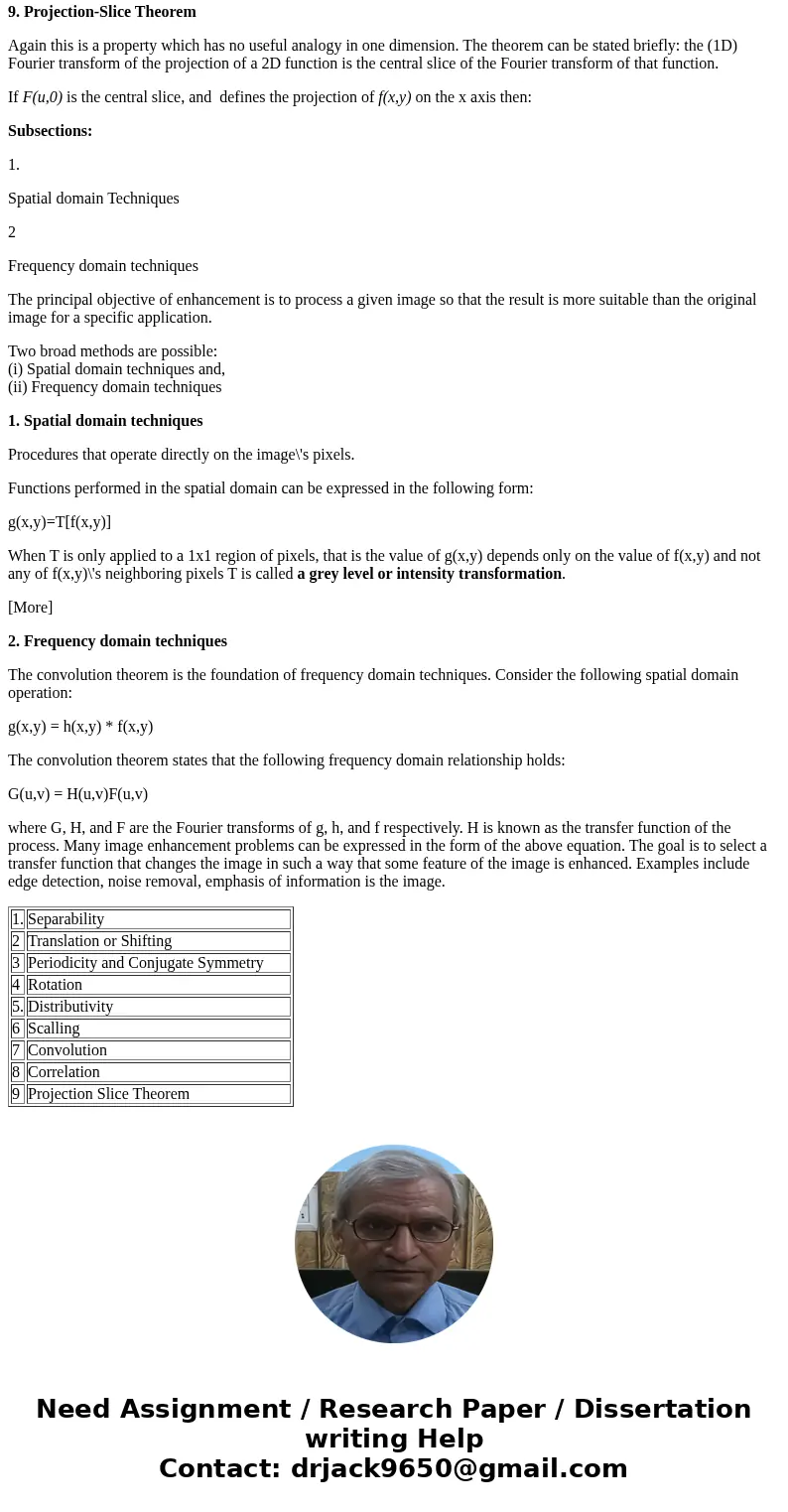a Use the time convolution property and the attached table o
Solution
DFT Properties:
1.
Separability
2
Translation or Shifting
3
Periodicity and Conjugate Symmetry
4
Rotation
5.
Distributivity
6
Scalling
7
Convolution
8
Correlation
9
Projection Slice Theorem
1. Separability
The 2D FT can be implemented as two consecutive 1D FTs: first in the x direction, then in the y direction (or vice versa). Symbolically:
The computation of the 2-D Fourier transform as a series of 1-D transforms.
[More]
2. Translation or Shifting
The FT of a shifted function is unaltered except for a linearly varying phase factor.
[More]
3. Periodicity and Conjugate Symmetry
The DFT and IDFT are periodic with period N ; that is:
[More]
4. Rotation
Simply stated: if a function is rotated, then its Fourier transform rotates an equal amount.
[More]
5. Distributivity
The Fourier transform and its inverse are distributive over addition but not over multiplication.
6.Scaling
This property is best summarized by \"a contraction in one domain produces corresponding expansion in the Fourier domain\".
7.Convolution
The convolution of two functions f(x) and g(x) is defined by the integral:
The Convolution Theorem tells us that convolution in the spatial domain corresponds to multiplication in the frequency domain, and vice versa.
[More]
8. Correlation
One of the principal applications of correlation in image processing is in the area of template or prototype matching i.e. finding the closest match between an unknown image and a set of known images.
[More]
9. Projection-Slice Theorem
Again this is a property which has no useful analogy in one dimension. The theorem can be stated briefly: the (1D) Fourier transform of the projection of a 2D function is the central slice of the Fourier transform of that function.
If F(u,0) is the central slice, and defines the projection of f(x,y) on the x axis then:
Subsections:
1.
Spatial domain Techniques
2
Frequency domain techniques
The principal objective of enhancement is to process a given image so that the result is more suitable than the original image for a specific application.
Two broad methods are possible:
(i) Spatial domain techniques and,
(ii) Frequency domain techniques
1. Spatial domain techniques
Procedures that operate directly on the image\'s pixels.
Functions performed in the spatial domain can be expressed in the following form:
g(x,y)=T[f(x,y)]
When T is only applied to a 1x1 region of pixels, that is the value of g(x,y) depends only on the value of f(x,y) and not any of f(x,y)\'s neighboring pixels T is called a grey level or intensity transformation.
[More]
2. Frequency domain techniques
The convolution theorem is the foundation of frequency domain techniques. Consider the following spatial domain operation:
g(x,y) = h(x,y) * f(x,y)
The convolution theorem states that the following frequency domain relationship holds:
G(u,v) = H(u,v)F(u,v)
where G, H, and F are the Fourier transforms of g, h, and f respectively. H is known as the transfer function of the process. Many image enhancement problems can be expressed in the form of the above equation. The goal is to select a transfer function that changes the image in such a way that some feature of the image is enhanced. Examples include edge detection, noise removal, emphasis of information is the image.
| 1. | Separability |
| 2 | Translation or Shifting |
| 3 | Periodicity and Conjugate Symmetry |
| 4 | Rotation |
| 5. | Distributivity |
| 6 | Scalling |
| 7 | Convolution |
| 8 | Correlation |
| 9 | Projection Slice Theorem |



 Homework Sourse
Homework Sourse